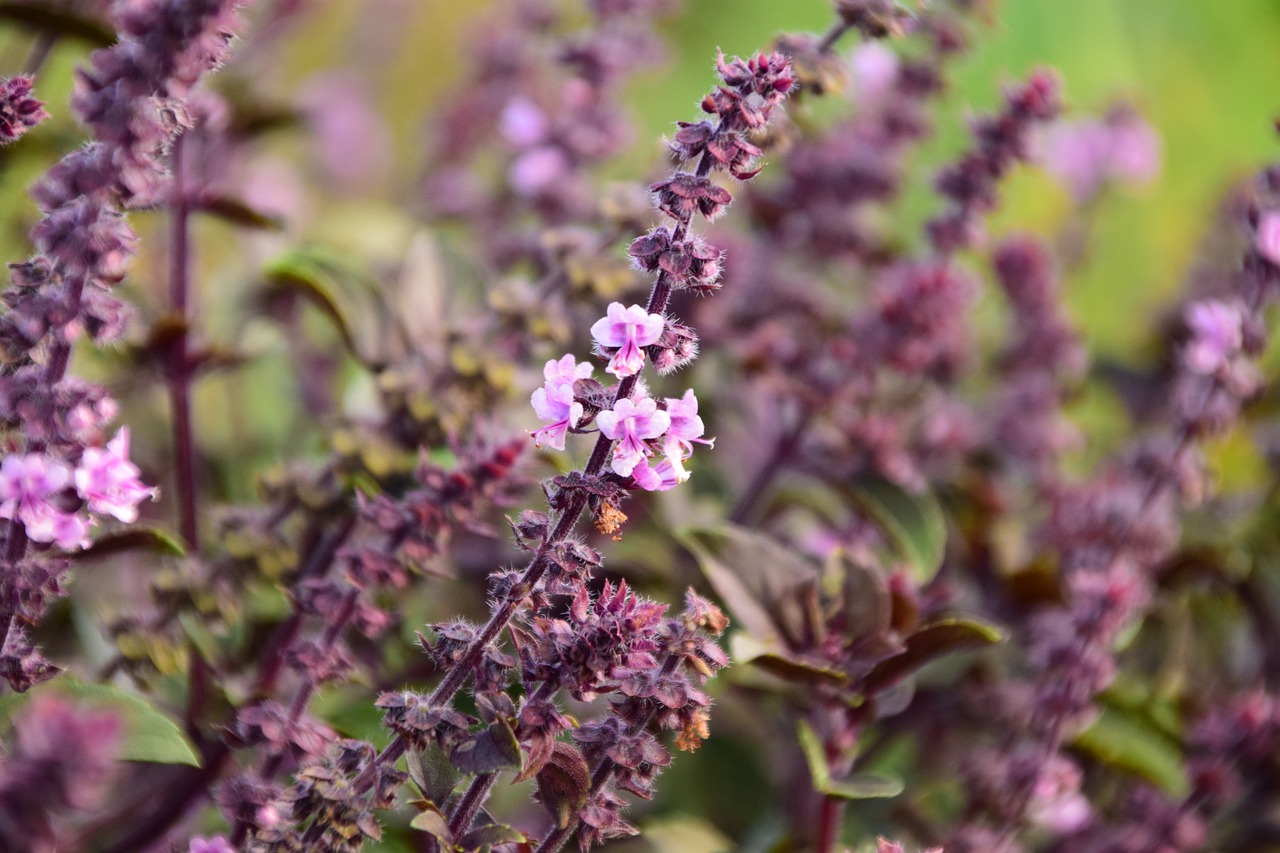Companion planting involves strategically placing different plants together to benefit one another by enhancing growth, deterring pests, and improving overall garden health. Here are 21 companion plants that are often recommended for roses:
1. Lavender (Lavandula spp.):
Attracts pollinators and beneficial insects, while repelling pests like aphids. Complements the beauty of roses with its vibrant blooms.
Benefits of Lavender for Roses:
• Pollinator Magnet: Lavender emits a highly attractive aroma to pollinators such as bees and butterflies. When pollinators visit lavender flowers for nectar, they also aid in pollinating the rose flowers, enhancing the potential for fertilization and fruit development.
• Pest Repellent: Lavender’s strong fragrance can help repel pests, including aphids. This helps protect roses from pest infestations that can damage leaves and flowers.
• Predator Insect Attractor: Lavender can also draw predator insects like predatory bees and ladybugs, which assist in controlling pest populations in the garden. These insects help reduce pest issues on roses.
How to Plant Lavender with Roses:
• Ensure that you plant both lavender and roses in an area that receives an adequate amount of sunlight. Both require full sun or at least sufficient sunlight.
• Plant lavender around the rose area to serve as a natural pollinator hub. Position lavender near roses, but not too close to avoid interfering with rose growth.
• Ensure that the soil around roses and lavender has good drainage. Both plants do not thrive in overly moist soil.
• Regularly inspect the plants to ensure there are no spreading pests or diseases. If any issues arise, take necessary actions to address them.
It’s important to remember that each garden has unique conditions, so results may vary. Lavender is a popular choice as a companion plant for roses due to its aromatic benefits involving pollinators and pest predators.
With proper care, both can collaborate harmoniously to create a beautiful and healthy garden.
2. Geraniums (Pelargonium spp.):
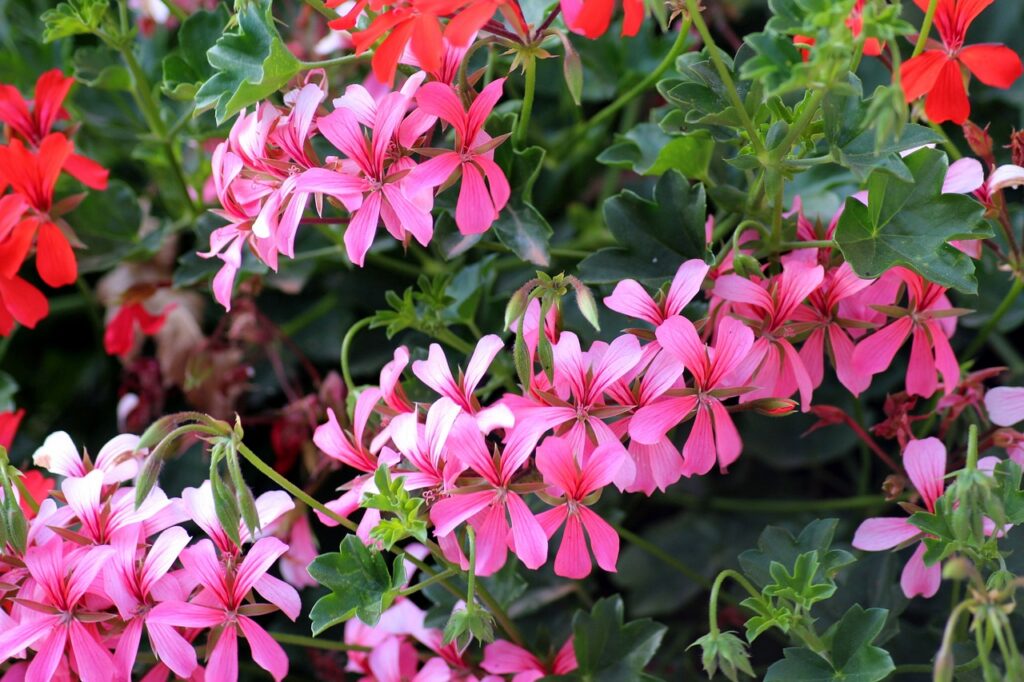
Benefits of Geraniums for Roses:
• Japanese Beetle Deterrent: Geraniums are known to emit a scent that repels Japanese beetles, which are pests that can cause damage to rose foliage by feeding on it. By planting geraniums near roses, you can help protect the roses from these destructive insects.
• Colorful Addition: Geraniums come in a variety of vibrant colors, adding aesthetic appeal to the garden and complementing the beauty of roses.
How to Plant Geraniums with Roses:
• Choose a location for planting geraniums that receives sufficient sunlight, as both geraniums and roses thrive in sunny conditions.
• Plant geraniums around the perimeter of the rose garden or intersperse them between rose bushes. This placement will help create a barrier that deters Japanese beetles from approaching the roses.
• Ensure that the soil is well-draining and of good quality, as healthy soil contributes to the overall well-being of both geraniums and roses.
• Regularly monitor the geraniums and roses for signs of Japanese beetle activity or any other issues. If you notice any problems, take appropriate steps to address them.
By incorporating geraniums as companion plants for roses, you not only provide a natural defense against Japanese beetles but also enhance the visual appeal of your garden through the colorful and charming presence of geranium blooms.
3. Marigolds (Tagetes spp.):
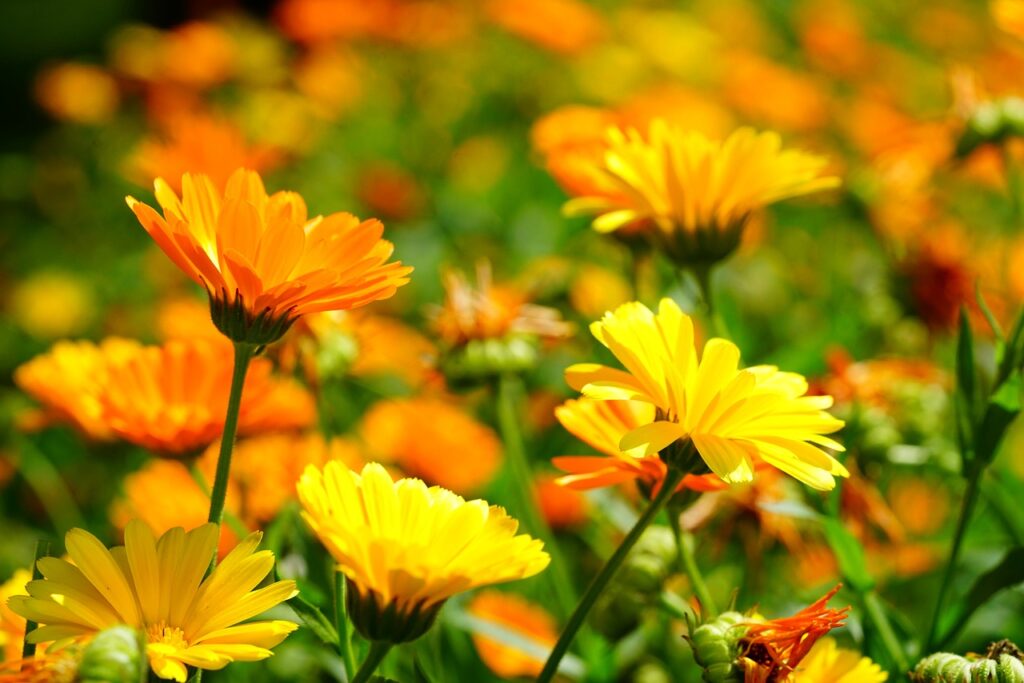
Repels aphids and nematodes, adds vibrant color to the garden, and improves soil health.
Benefits of Marigolds for Roses:
• Aphid and Nematode Repellent: Marigolds emit a strong scent that repels aphids, which can be harmful to roses. Additionally, marigolds are known for their ability to deter nematodes, microscopic soil-dwelling pests that can damage plant roots.
• Soil Improvement: Marigolds have the ability to improve soil health by releasing certain compounds that suppress harmful soil-borne pathogens.
How to Plant Marigolds with Roses:
• Plant marigolds around the base of rose bushes or in rows nearby to create a protective border.
• Marigolds require well-draining soil and prefer full sun, so ensure they receive proper sunlight and water.
• Regularly deadhead (remove spent blooms) marigold flowers to encourage continuous blooming and overall plant health.
4. Nasturtiums (Tropaeolum spp.):
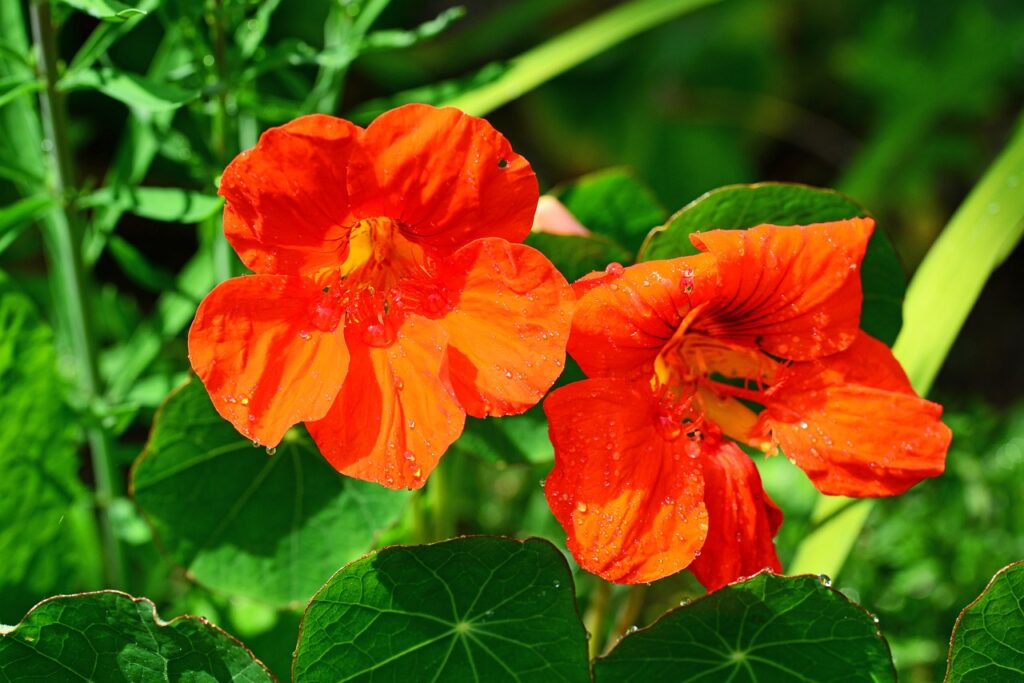
Acts as a sacrificial plant by attracting aphids away from roses. Can also act as ground cover.
Benefits of Nasturtiums for Roses:
• Aphid Trap Plant: Nasturtiums attract aphids away from roses, acting as a sacrificial plant. Aphids are more likely to infest nasturtiums instead of roses.
• Ground Cover: Nasturtiums can act as ground cover, shading the soil around roses and helping to retain moisture.
How to Plant Nasturtiums with Roses:
• Plant nasturtiums near the base of rose bushes or around the garden perimeter.
• Nasturtiums prefer well-draining soil and can tolerate partial shade, but they generally thrive in full sun.
• Regularly monitor nasturtium plants for aphid infestations and take appropriate action if necessary.
5. Chives (Allium schoenoprasum):

Repels aphids and helps deter black spot disease. Attracts beneficial insects like hoverflies.
• Aphid Repellent: Chives emit a scent that repels aphids, helping to protect roses from infestations.
• Disease Prevention: Chives may also help deter fungal diseases like black spot due to their natural compounds.
How to Plant Chives with Roses:
• Plant chives around the base of rose bushes or in proximity to rose beds.
• Chives prefer well-draining soil and partial to full sun.
• Harvest chive leaves for culinary use, but avoid removing too much foliage to ensure the plant’s health.
6. Catmint (Nepeta spp.):

Attracts predator insects like ladybugs and lacewings. Complements rose colors with its purple flowers.
Benefits of Catmint for Roses:
• Predator Insect Attractor: Catmint attracts beneficial predator insects like ladybugs and lacewings, which feed on aphids and other pests.
• Color and Aesthetic Appeal: Catmint’s purple flowers add visual interest to the garden and complement the colors of many rose varieties.
How to Plant Catmint with Roses:
• Plant catmint near rose bushes to encourage predator insects to inhabit the area.
• Catmint prefers well-draining soil and full sun to partial shade.
• Trim back catmint after its first bloom to encourage a second round of flowering.
7. Oregano (Origanum spp.):
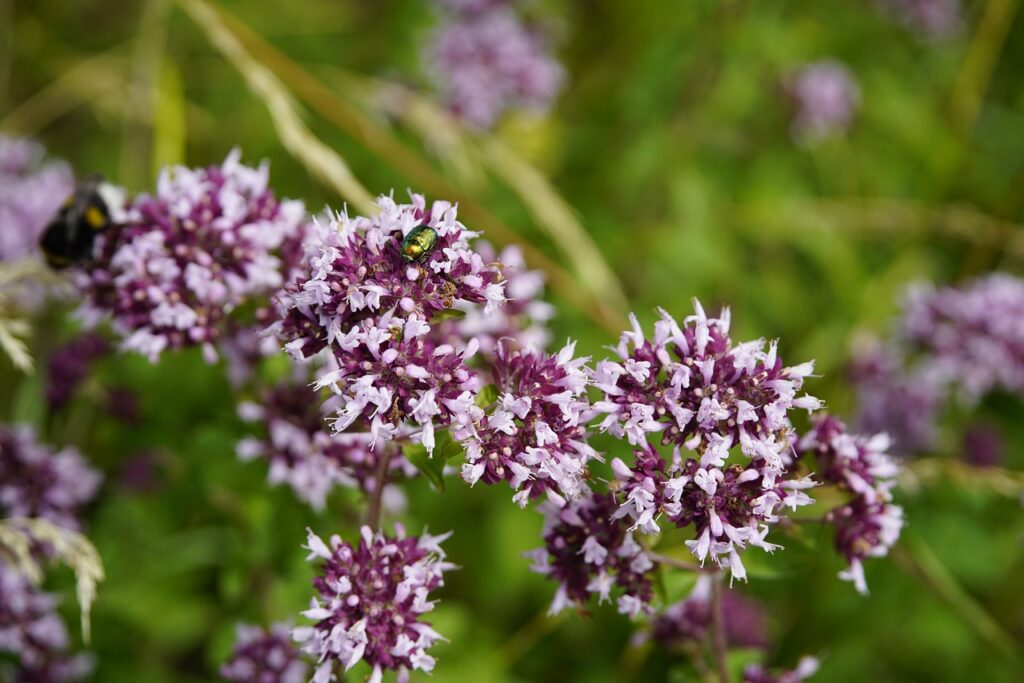
Repels pests and improves overall rose health. Leaves can be harvested for culinary use.
Benefits of Oregano for Roses:
• Pest Repellent: Oregano has a strong aroma that can help repel pests from roses.
• Soil Health: Oregano can improve soil health and inhibit the growth of some soil-borne pathogens.
How to Plant Oregano with Roses:
• Plant oregano near rose bushes or in close proximity to the garden.
• Oregano prefers well-draining soil and full sun.
• Regularly trim oregano to encourage bushier growth and maintain its health.
8. Dianthus (Dianthus spp.):
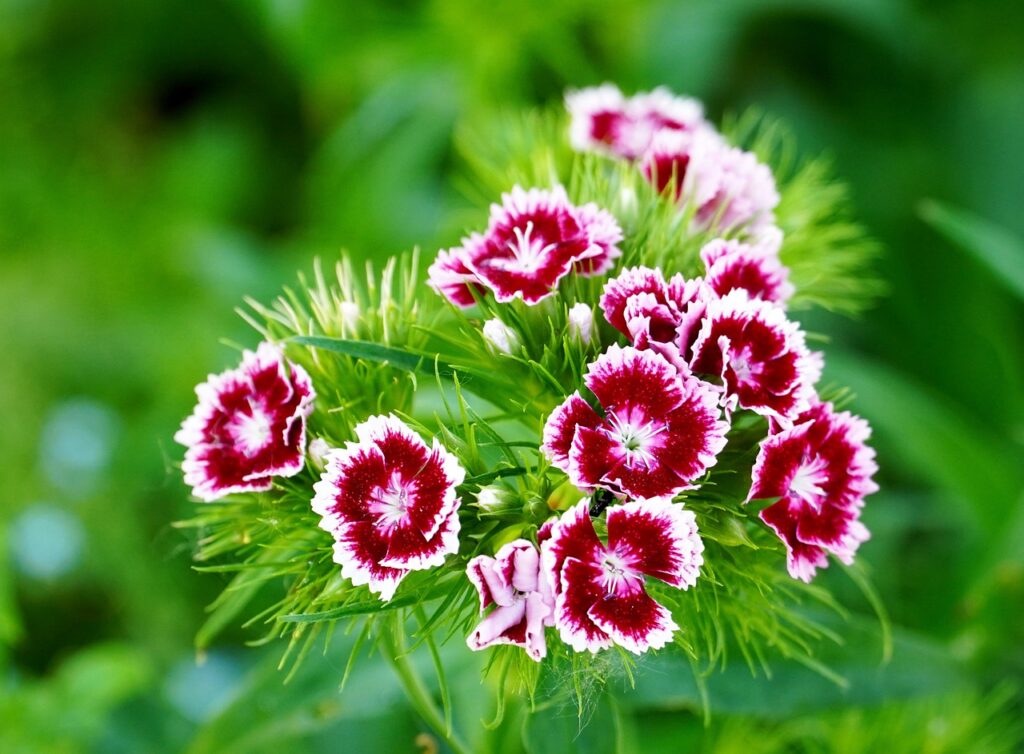
Provides color and fragrance while deterring pests like aphids and spider mites.
Benefits for Roses:
• Color and Fragrance: Dianthus, commonly known as “pinks,” adds a burst of color to the garden with its vibrant blooms, which can range from pink to red and white. Its delightful fragrance also enhances the sensory experience of the garden.
• Pest Deterrent: Dianthus emits a scent that deters pests like aphids and spider mites, helping to protect roses from infestations.
How to Plant Dianthus with Roses:
• Plant dianthus around the base of rose bushes or in nearby areas to create an attractive border.
• Ensure well-draining soil and provide adequate sunlight, as both dianthus and roses thrive in similar conditions.
• Regularly deadhead (remove spent blooms) dianthus flowers to encourage continuous flowering and maintain plant health.
9. Alliums (Allium spp.):
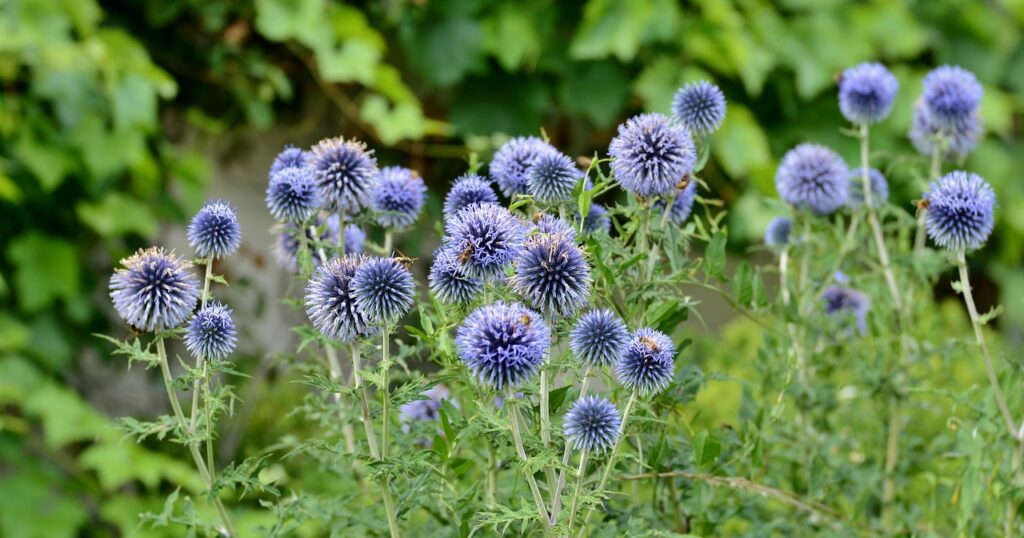
Repel aphids, Japanese beetles, and other pests while adding vertical interest to the garden.
Benefits for Roses:
• Pest Repellent: Alliums, including ornamental varieties like garlic chives and ornamental onions, emit a scent that repels aphids, Japanese beetles, and other pests, reducing the risk of pest damage to roses.
• Vertical Interest: The tall and distinctive flower stalks of alliums provide vertical interest in the garden, creating a visually appealing backdrop for rose bushes.
How to Plant Alliums with Roses:
• Plant allium bulbs in the vicinity of rose bushes to deter pests and add visual variety.
• Alliums prefer well-draining soil and sunlight, so ensure appropriate growing conditions.
• Choose different varieties of alliums for a mix of flower shapes and sizes that complement the roses.
10. Yarrow (Achillea spp.):
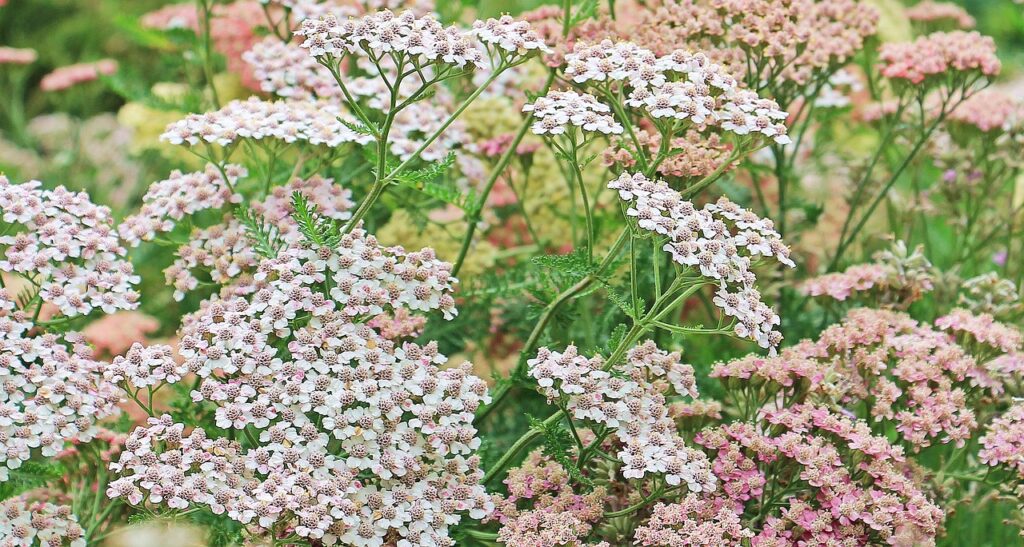
Attracts beneficial insects, improves soil health, and adds a different texture to the garden.
Benefits for Roses:
• Beneficial Insects: Yarrow attracts beneficial insects like ladybugs, lacewings, and parasitic wasps, which help control aphid and other pest populations in the garden.
• Soil Improvement: Yarrow’s deep roots help break up compacted soil and improve soil structure, enhancing water and nutrient penetration.
How to Plant Yarrow with Roses:
• Plant yarrow near rose bushes or in areas with full sun and well-draining soil.
• Prune spent blooms to encourage continuous flowering and prevent self-seeding.
• Allow some yarrow flowers to go to seed to provide food for beneficial insects.
11. Sage (Salvia spp.):
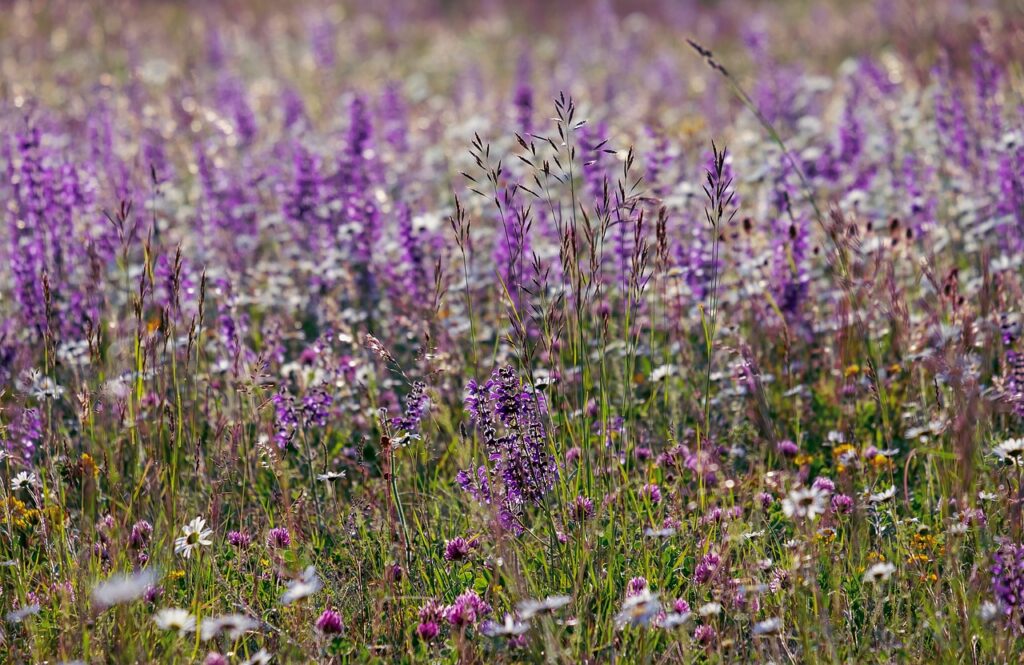
Repels pests and adds a variety of foliage colors and textures.
Benefits for Roses:
• Pest Repellent: Sage emits a strong aroma that repels pests such as aphids, cabbage moths, and carrot flies, reducing the risk of pest damage to roses.
• Foliage Diversity: Sage offers a variety of foliage colors, textures, and sizes, adding visual interest and contrast to the garden.
How to Plant Sage with Roses:
• Plant sage near rose bushes to deter pests and provide a unique foliage element.
• Sage thrives in well-draining soil and full sun conditions.
• Prune sage plants regularly to maintain their shape and promote healthy growth.
12. Thyme (Thymus spp.):
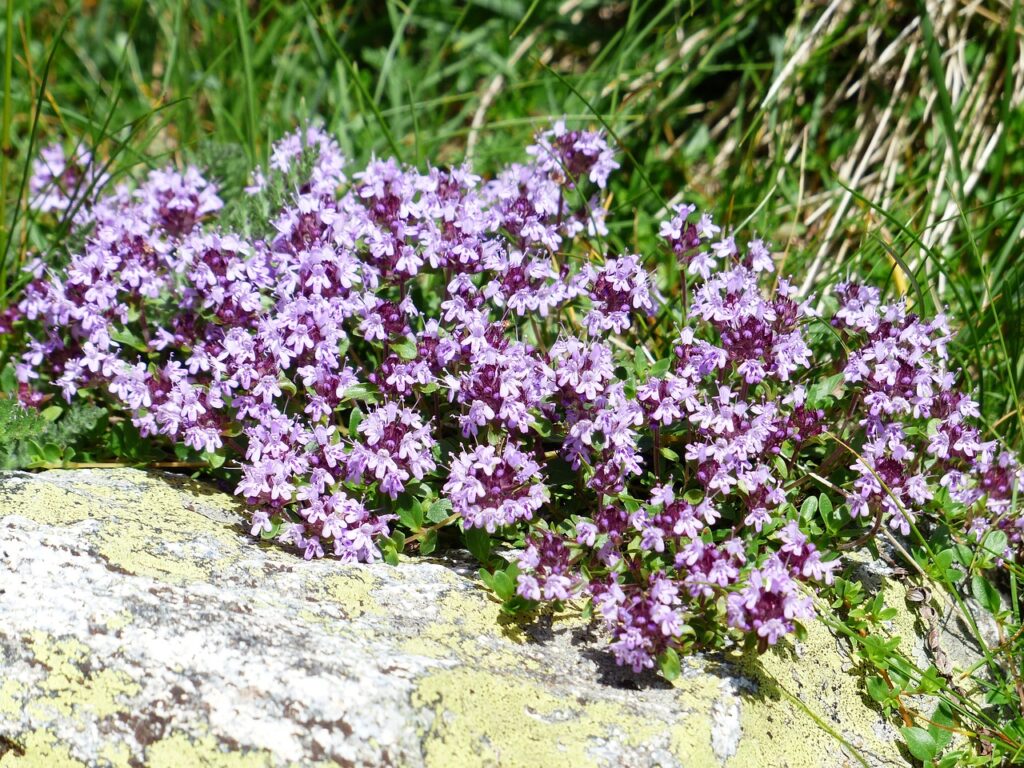
Repels pests and serves as a low-growing ground cover.
Benefits for Roses:
• Pest Repellent: Thyme releases aromatic oils that repel pests like cabbage worms, whiteflies, and slugs, helping protect roses from infestations.
• Ground Cover: Low-growing thyme varieties can act as a ground cover, reducing weed growth and conserving soil moisture.
How to Plant Thyme with Roses:
• Plant thyme around the base of rose bushes or as a border plant.
• Ensure well-draining soil and provide plenty of sunlight.
• Trim thyme plants after flowering to promote bushy growth and maintain a tidy appearance.
13. Mint (Mentha spp.):

Deters aphids and other pests while providing aromatic leaves for culinary use.
Benefits for Roses:
• Aphid Deterrent: Mint releases a strong scent that deters aphids and other pests from roses, helping to prevent infestations.
• Culinary Use: Mint leaves can be harvested and used for culinary purposes, adding a versatile herb to your garden.
How to Plant Mint with Roses:
• Plant mint near rose bushes to deter pests and provide a useful culinary herb.
• Mint prefers partial shade to full sun and well-draining soil.
• Consider planting mint in containers to prevent its spreading growth habit from becoming invasive.
14. Calendula (Calendula officinalis):
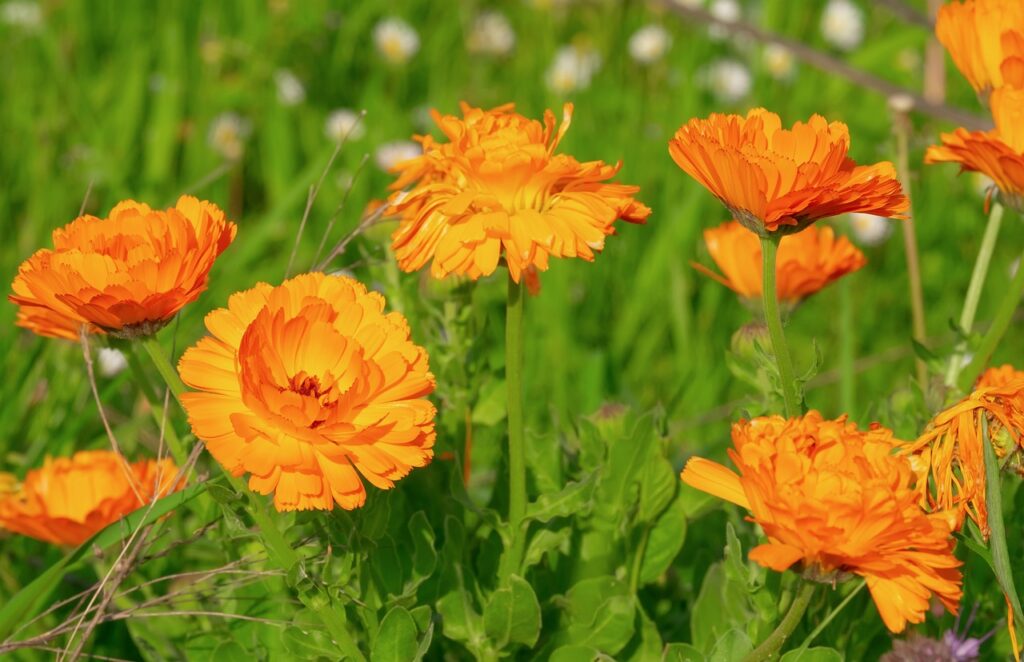
Attracts beneficial insects and adds bright orange and yellow hues to the garden.
Benefits for Roses:
• Beneficial Insects: Calendula attracts pollinators and beneficial insects like hoverflies and ladybugs, which help control aphid populations in the garden.
• Color and Contrast: Calendula’s bright orange and yellow blooms provide a striking contrast to the colors of roses.
How to Plant Calendula with Roses:
• Plant calendula near rose bushes to attract pollinators and beneficial insects.
• Ensure well-draining soil and provide full sun or partial shade.
• Deadhead spent calendula flowers to promote continuous blooming.
15. Echinacea (Echinacea spp.):
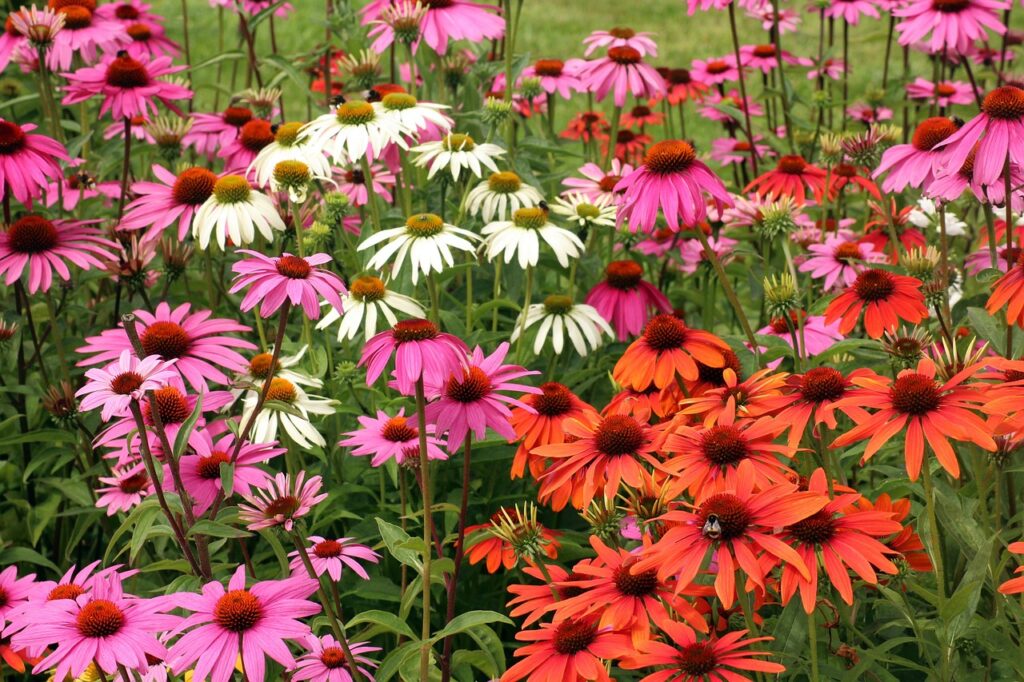
Attracts pollinators and provides visual interest with its unique flower shape.
Benefits for Roses:
• Pollinator Attraction: Echinacea, commonly known as coneflowers, attract pollinators like bees and butterflies, enhancing cross-pollination of rose flowers.
• Visual Interest: Echinacea’s unique flower shape and color add visual intrigue to the garden landscape.
How to Plant Echinacea with Roses:
• Plant echinacea near rose bushes to attract pollinators and create a visually appealing garden.
• Provide well-draining soil and full sun conditions for optimal growth.
• Allow some echinacea seed heads to remain in the garden to provide food for birds in the winter.
16. Salvia (Salvia spp.):
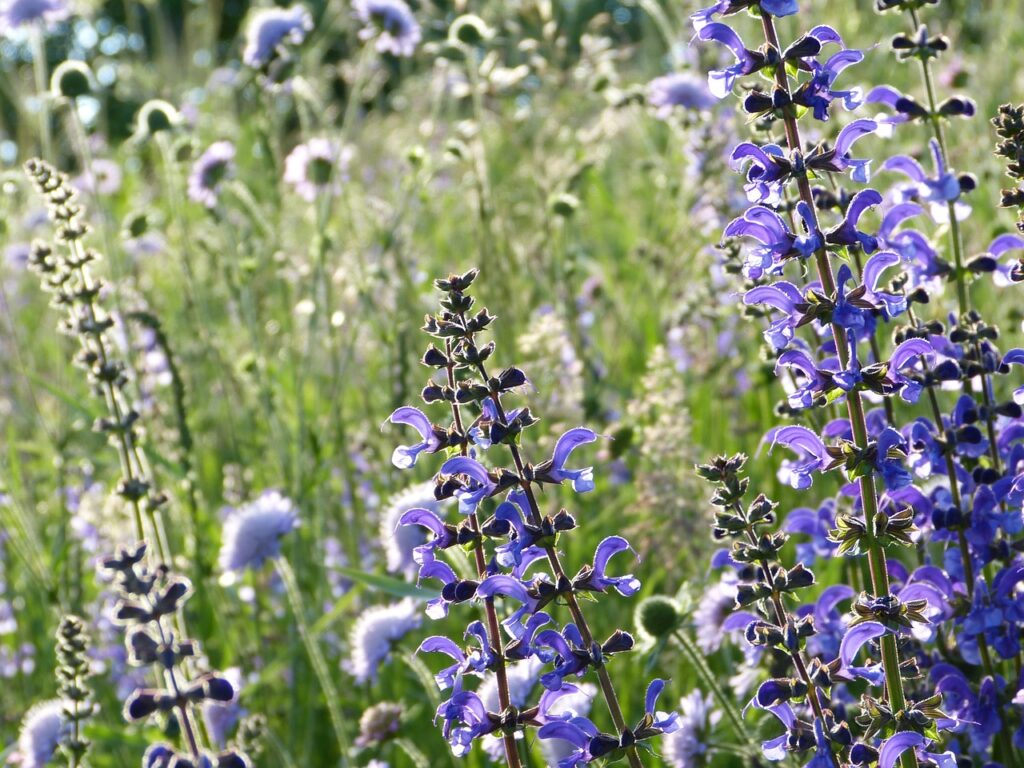
Repels pests and offers a wide range of colors and sizes to choose from.
Benefits for Roses:
• Pest Repellent: Salvia emits a scent that deters pests like aphids, making it an effective companion plant for pest control in the rose garden.
• Color Diversity: Salvia comes in a wide range of colors and sizes, allowing for creative combinations with rose varieties.
How to Plant Salvia with Roses:
• Plant salvia near rose bushes to repel pests and introduce diverse colors to the garden.
• Provide well-draining soil and full sun conditions for optimal growth.
• Prune salvia plants after flowering to encourage bushy growth and repeat blooming.
17. Borage (Borago officinalis):
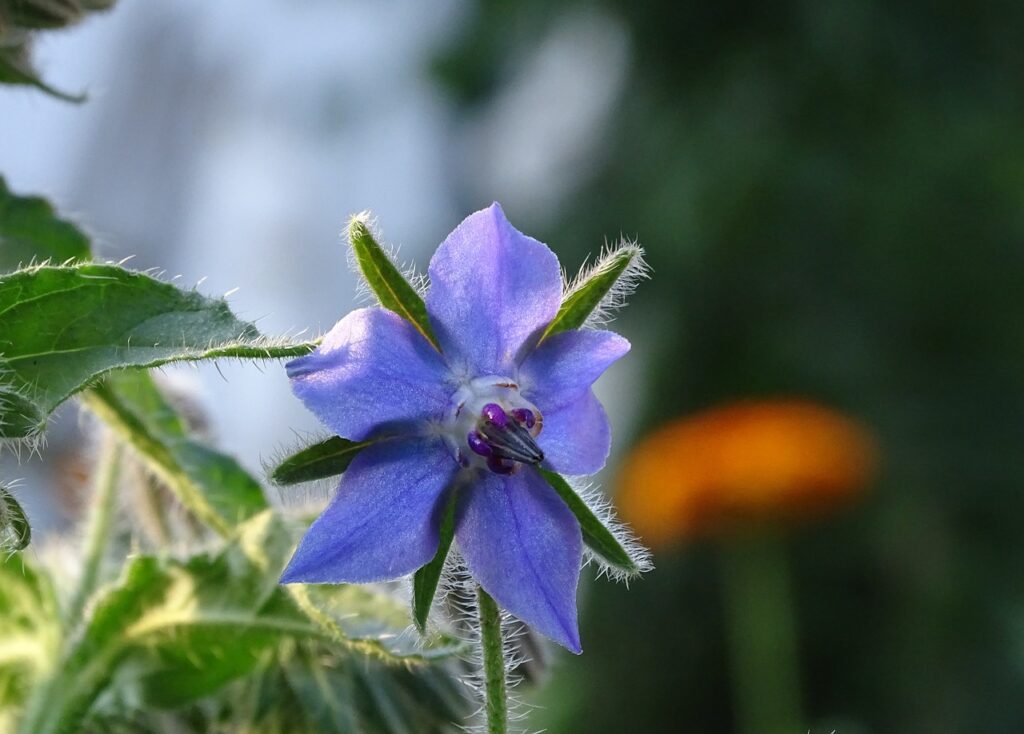
Attracts pollinators and deters tomato hornworms, which can also affect roses.
Benefits for Roses:
• Pollinator Attraction: Borage is a pollinator magnet, particularly attracting bees to its blue star-shaped flowers. This increased pollination activity can lead to better fruit set in roses and overall garden biodiversity.
• Pest Deterrent: Borage’s scent is known to repel certain pests, including tomato hornworms, which can impact roses.
How to Plant Borage with Roses:
• Plant borage near rose bushes or in the surrounding garden to attract pollinators and deter pests.
• Provide well-draining soil and full sun for optimal growth.
• Allow borage to self-seed, but be mindful of its potential to spread aggressively.
18. Alyssum (Lobularia maritima):
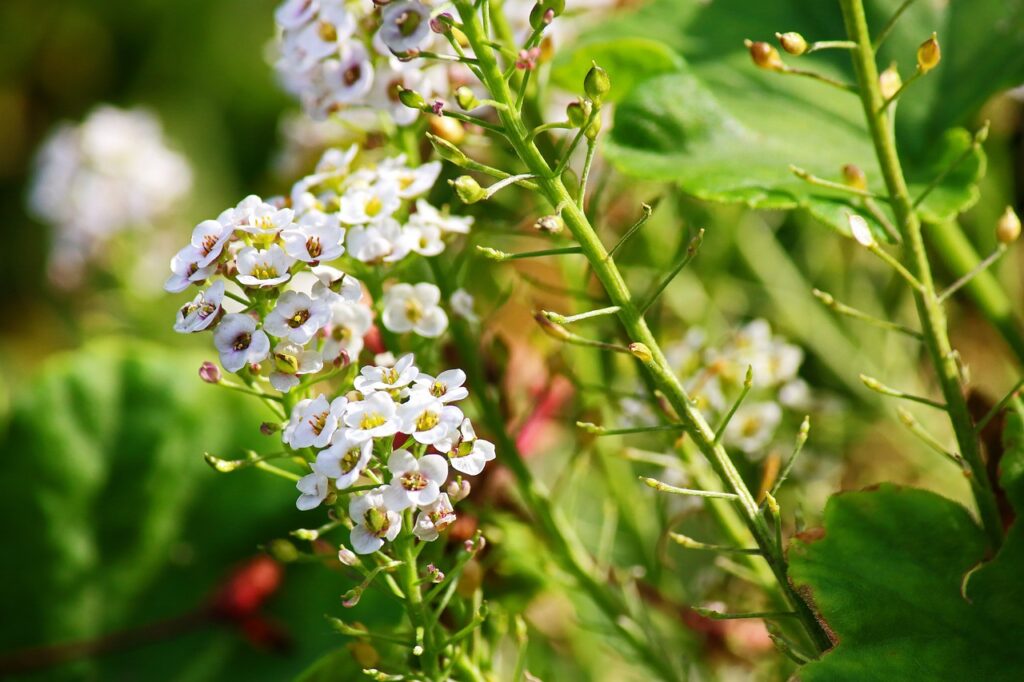
Acts as a ground cover, attracting beneficial insects and adding a sweet fragrance.
Benefits for Roses:
• Beneficial Insects: Alyssum attracts beneficial insects like parasitic wasps and hoverflies, which prey on pests like aphids and whiteflies, contributing to natural pest control.
• Ground Cover: Alyssum acts as a low-growing ground cover, helping to suppress weed growth and maintain soil moisture.
How to Plant Alyssum with Roses:
• Plant alyssum near the base of rose bushes to attract beneficial insects.
• Choose well-draining soil and a location with full sun to partial shade.
• Regularly deadhead alyssum flowers to promote continuous blooming.
19. Rudbeckia (Rudbeckia spp.):

Attracts pollinators and adds a burst of yellow or orange color to the garden.
Benefits for Roses:
• Pollinator Attraction: Rudbeckia, commonly known as black-eyed Susans, attract pollinators like bees and butterflies, enhancing pollination of rose flowers.
• Visual Interest: Rudbeckia’s vibrant yellow or orange blooms add a splash of color and contrast to the garden.
How to Plant Rudbeckia with Roses:
• Plant rudbeckia near rose bushes to attract pollinators and create visual diversity.
• Provide well-draining soil and full sun conditions for optimal growth.
• Deadhead spent rudbeckia flowers to encourage continuous blooming and prevent self-seeding.
20. Feverfew (Tanacetum parthenium):
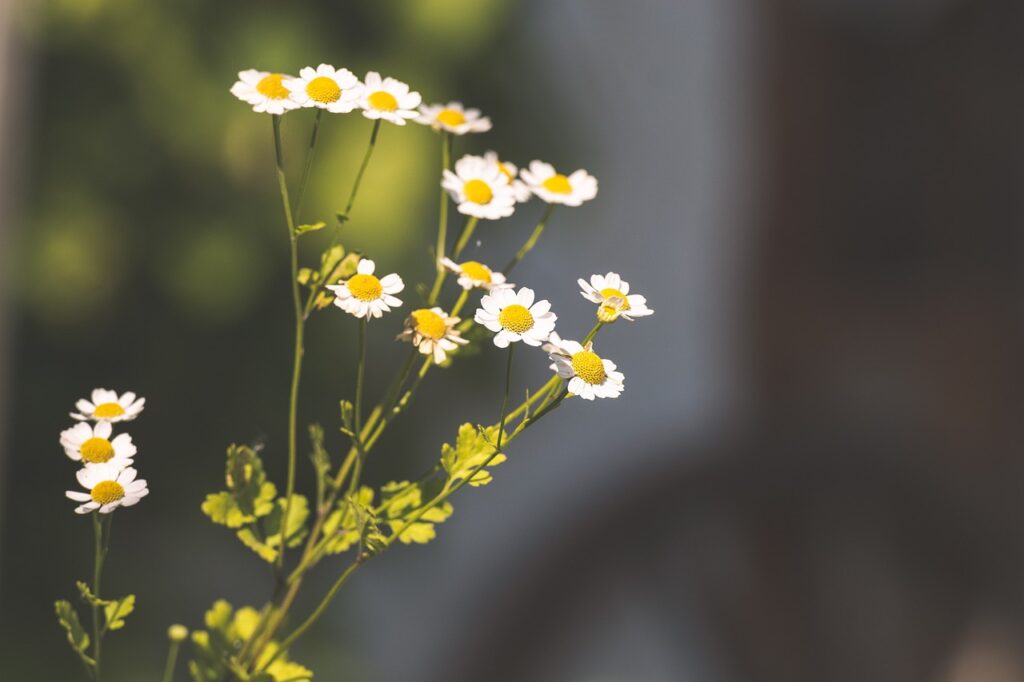
Repels pests and provides delicate white blooms.
Benefits for Roses:
• Pest Repellent: Feverfew emits a strong aroma that repels pests, including aphids and various flying insects, contributing to pest management in the rose garden.
• Natural Beauty: Feverfew’s daisy-like blooms provide a charming and delicate aesthetic appeal to the garden.
How to Plant Feverfew with Roses:
• Plant feverfew near rose bushes to take advantage of its pest-repellent properties.
• Choose a location with well-draining soil and exposure to full sun or partial shade.
• Deadhead spent feverfew flowers to promote continuous blooming and prevent self-seeding.
21. Cosmos (Cosmos spp.):
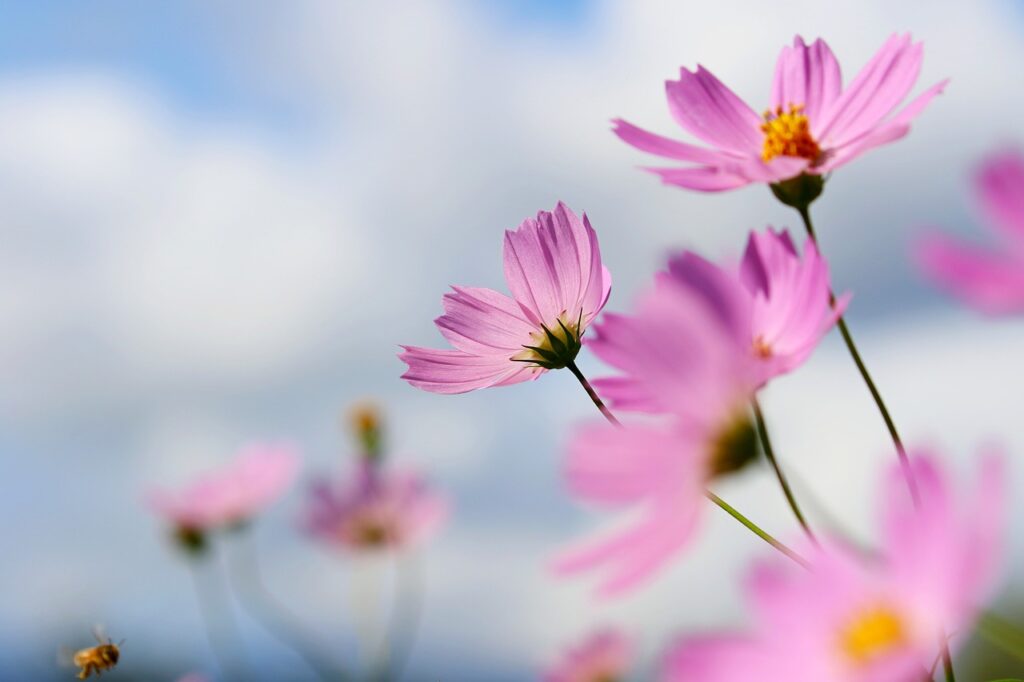
Attracts pollinators and adds tall, airy foliage and colorful blooms to the garden.
Benefits for Roses:
• Pollinator Attraction: Cosmos flowers are a favorite among pollinators, including bees and butterflies, enhancing pollination of rose flowers and increasing garden biodiversity.
• Visual Impact: Cosmos’ tall and airy growth habit, along with its diverse range of colors, adds texture and visual interest to the garden landscape.
How to Plant Cosmos with Roses:
• Plant cosmos near rose bushes to attract pollinators and create a vibrant garden display.
• Provide well-draining soil and full sun conditions for optimal growth.
• Deadhead spent cosmos flowers to promote continuous blooming and encourage further flowering.
When selecting companion plants for your roses, consider factors such as the specific type of rose, sunlight requirements, soil conditions, and regional climate.
Planting a diverse selection of these companion plants can help create a balanced and thriving garden ecosystem that supports the health and beauty of your roses.
When selecting companion plants for roses, consider factors such as sunlight requirements, soil preferences, and growing conditions to ensure that both plants thrive together.
Keep in mind that while companion planting can offer benefits, it’s important to monitor your garden regularly and take appropriate measures if any issues arise.
